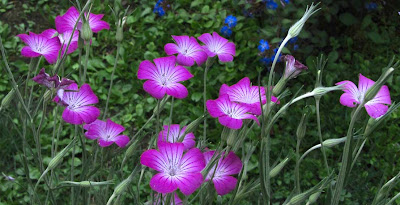 |
| Agrostemma githago 'Milas Purple Queen' (corncockle) |
I may have mentioned before that French garden centres - in our area at least - tend to stock only those stalwart plant varieties that we’ve all seen before, thus leaving little scope for imagination and invention. When I first became interested in growing things, I loved to turn the pages of Bressingham’s catalogue because it was so bountifully illustrated with appealing images of species I’d never seen before.
 |
| Agastache aurantiaca |
Since then, I’ve moved on to raising my own perennials from seed and look forward to the arrival of the annual 200-page booklet from Chiltern Seeds. What it lacks in photo’s, it more than makes up in the diversity of plants on offer, presented in a witty and informative way, inspiring me to order lots of little packets through the post!
I'd never even thought of growing a herb called hyssop until I read their glowing descriptions and decided to start with the small, orange-flowered Agastache aurantiaca, which grows about a foot high and flowers the first year from seed. (In the above picture, its colour is heightened by a stray seedling of Cosmos sulphureus which happened to come out at the same time!)
 |
| Agastache 'Liquorice Blue' |
Another variety that has since seeded itself in the garden is Agastache 'Liquorice Blue', so-called because its leaves really do smell of liquorice.
 |
| Agastache mexicana 'Sangria' |
Rather more colourful and dramatic is my favourite Agastache mexicana 'Sangria', which has lemon-scented leaves (useful for salads) and the most gorgeous magenta flowers. Grown in an open area with plenty of sun, it can reach over a meter in height.
I’m a huge fan of salvias, which come in all shapes and sizes from every corner of the world and are generally quite easy to grow. (Chiltern Seeds latest catalogue lists over 40 varieties and I should think I’m only up to number eight!) Being a herb, they usually have pleasantly aromatic leaves which can be added to salads, and striking flowers in shades of red, white, purple or blue, which can really perk up a border at this time of year.
 |
| Anenome japonica 'Honorine Jobert' |
Here in Charente Maritime, however, some varieties can run amok and we rue the day that we planted a pink-flowered anenome nearby; now the shoots have popped up everywhere and it's nigh impossible to eradicate, insinuating itself between the roots of gentler plants.
On the other hand, there are a few choice hybrids to be found, including this darker pink double Anenome hupehensis, which is slightly more demanding than 'Honorine Jobert' but with no nasty habits.
Another mainstay of the semi-shaded border at this time of year is the sedum family, especially good old Sedum spectabile which looks so wonderful next to the ground-cover plumbago, Ceratostigma plumbaginoides, with its gentian-blue flowers.
 |
| Sedum with Ceratostigma |
There are two versions of this hardy plumbago in our garden: the rather invasive but extremely useful low-growing form in this photo, and the taller (90cm) Ceratostigma plumbaginoides Willmottianum, which is a more restrained back-of-the-border plant. Both types have leaves which gain some bold red tints when the cold weather arrives.
Larger sedums have the unfortunate habit of collapsing under the weight of their blooms, leaving an unsightly gap in the middle. Some brave souls give them a 'Chelsea Chop' midway through their growth cycle, but this year we've re-used the mesh shelves from some old wire and plastic staging. Just bend the metal into a 'V' and push it under the plant for support - I find I can gently tip them up with my foot when strimming the grass underneath!
Back on the subject of seeds, I was a bit slow in sowing some love-in-the-mist ordered from Chiltern's and they've only recently come into flower, long after the ordinary blue ones are dried and papery.
 |
| The exotic Nigella hispanica "African Bride' |
Phew, I'm off to have a siesta!



No comments:
Post a Comment